Numerical Modelling Of The Impact-echo Method For Materials Characterisation
Price
Free (open access)
Transaction
Volume
37
Pages
Published
2002
Size
475 kb
Paper DOI
10.2495/DM020271
Copyright
WIT Press
Author(s)
R Medina & M Garrido
Abstract
Numerical modelling of the impact-echo method for materials characterisation R. Medina1 & M. Garrido2 1Departamento de Fisica Aplicada a los Reurscos Naturales Universidad Politecnica de Madrid, Spain. 2Departamento de Explotacion de Recursos Minerales y Obras Subterraneas, Universidad Politecnica de Madrid, Spain. Abstract The impact-echo method uses stress waves that propagate in media to detect internal flaws in materials and delaminations between layers of different materials. It can be used in certain heterogeneous media (concrete, asphalt) in which ultrasonic methods do not yield good results. This work evaluates, with finite elements simulation, the influence of several parameters that affect the results of the test: size of impact region, time of impact, border effects, time of recording or position of the transducer. This study investigates how wave propagation in a concrete plate is affected by the interferences with waves generated when the original wave rebounds from the borders of a plate. This effect is shown graphically and the visual information thus obtained can be used to avoid the aforesaid problem changing the recording time. The influence of the positioning of the transducer has been investigated in order to optimise this variable. The same questions have been addressed for concrete slabs with asphalt overlays. Lastly, the influence of the size of the impact region on the accuracy of the detection of cracks in concrete plates and delaminations in the asphalt-concrete interface has been investigated. The different ways in which the wave propagates are shown graphically for several experimental conditions, and are related to the size of the impact region. It has been concluded that detection of cracks can be achieved with the impact-echo method but the results depend on different variables such as the position and size of the crack, the size of impact region, the location of transducer and the time of recording.
Keywords





